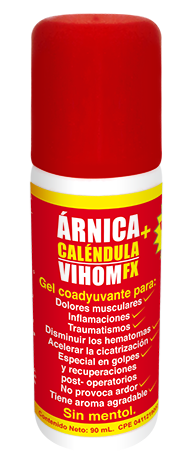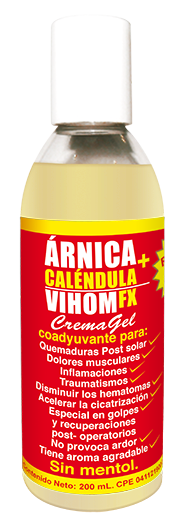
RIF.: J-30542508-6.

TU ALIVIO SEGURO PARA EL DOLOR
EL MAS COMPLETO Y EFECTIVO ALIVIO NATURAL DE USO EXTERNO.
TENLO SIEMPRE A TU ALCANCE.
IDEAL PARA:
DISMINUIR LOS HEMATOMAS.
ACELERAR LA CICATRIZACIÓN.
QUEMADURAS POST SOLAR.
DOLORES MUSCULARES.
INFLAMACIONES.
TRAUMATISMOS.
AYUDA EN:
DOLORES POR GOLPES.
LA RECUPERACIÓN DE PROCESOS POST-OPERATORIOS.
ALIVIAR ARDORES DE PICADURAS Y SALPULLIDOS.

VIHOM FX ROLL-ON
COMPOSICIÓN
Árnica Montana D1 - D6 - D12 - D30. Caléndula Officinalis D1 - D6 - D12 - D30. Vehículo hidrogel alcohólico p/p 20 g%g c.s.p 90 mL.
INDICACIONES
Coadyuvante en tratamientos como antiinflamatorio, analgésico, hematomas, traumatismos, dolores musculares y procesos post-operatorios.
MODO DE USO
Agítese antes de usar.
POSOLOGÍA
Aplicar directamente sobre la zona afectada 4 veces al día.
VÍA DE ADMINISTRACIÓN
Uso Tópico.
VIHOM FX CREMAGEL
COMPOSICIÓN
Árnica Montana D1 - D6 - D12 - D30. Caléndula Officinalis D1 - D6 - D12 - D30. Cremagel csp 200 mL.
INDICACIONES
Coadyuvante en tratamientos como antiinflamatorio, analgésico, hematomas, traumatismos, dolores musculares y procesos post-operatorios.
MODO DE USO
Presione hasta obtener la cantidad necesaria.
POSOLOGÍA
Aplicar directamente sobre la zona afectada 4 veces al día.
VÍA DE ADMINISTRACIÓN
Uso Tópico.

NO PROVOCA ARDOR Y TIENE AROMA AGRADABLE

UN POCO DE HISTORIA
HISTORIA DEL ÁRNICA
Historia
Citada en la Encyclopaedia of Matthaeus Sylvaticus (siglo XIV).
A partir del Siglo XVI comenzó a utilizarse como analgésico para uso externo.
A principios del Siglo XIX se incorporó como una herramienta básica dentro del arsenal médico disponible.
Descripción botánica:
Especie vegetal: Árnica (Árnica montana L.). Familia: Compositae (Asteraceae). Se la conoce también por otros nombres: Árnica chamissonis Less., Flor de tabaco, Tabaco de montaña, Talpica. Partes usadas: Inflorescencias. Alcanza una altura de hasta 50 cm. Su tallo es erguido y se presenta con pocas ramas, en cuya base se encuentra una roseta de hojas lanceoladas que se extienden sobre el suelo. Sus flores de color amarillo están ubicadas en un capítulo terminal. Las flores son tubulosas y liguladas y presentan un color amarillo anaranjado.
Distribución geográfica:
Oriunda de Europa Central y meridional, Asia Central y América del Norte, en zonas soleadas montañosas (Alpes), praderas y turberas. Actualmente se encuentra como especie protegida en España, Italia y Suiza.
Principios activos:
Aceite esencial (0,1-0.4%): terpenos, timol, florol, etc.
Alcoholes terpénicos: helenalina, dihidrohelenalina, y derivados (lactonas sesquiterpénicas), arnidiol, faradiol.
Ácidos fenólicos: ácido cafeico, ácido clorogénico y sus ésteres (cinarina).
Carotenoides: alfa y beta carotenos, zeaxantinas.
Flavonoides (0,2-0,6%): heterósidos de la hispidulina, patuletina, kaempferol, quercetina y otros.
Otros: taninos, arnicina, cumarinas, etc.
Acciones farmacológicas:
Antiinflamatorio
Analgésico.
Antiequimótico
ESTUDIOS CIENTÍFICOS
Estudio clínico comparativo: Gel de árnica frente a gel de ibuprofeno en el tratamiento tópico de la osteoartritis de la mano. Fitoterapia 2007; 7 (2): 101-112)
En los últimos años ha aumentado el uso de preparaciones tópicas a base de antiinflamatorios no esteroideos (AINEs) para el tratamiento de los dolores de la osteoartritis. El objetivo del presente estudio fue comparar la efectividad de los geles de ibuprofeno (5%) y árnica (50 g de tintura/100g, relación droga extracto 1:20) en el tratamiento de pacientes con osteoartritis interfalángicas de los dedos de las manos con alteraciones radiológicas significativas y sintomáticamente activas. En el estudio, aleatorizado, controlado, a doble ciego, participaron 204 pacientes, en 20 clínicas. Se evaluó la intensidad del dolor por medio de la escala analógica visual (VAS) y la funcionalidad, por medio del índice algofuncional de la mano (Hand Algofunctional Index, HAI).
Los dos tratamientos produjeron mejoras en todos los parámetros y los resultados demostraron que la efectividad del gel de árnica no es inferior a la del gel de ibuprofeno. Ambos tratamientos aliviaron los síntomas y fueron bien tolerados.
Árnica montana gel in osteoarthritis of the knee: an open multicenter clinical trial. Advances in Therapy 2002; 19 (5): 209-218)
This open multicenter trial investigated the safety and efficacy of anÁrnica montana fresh plant gel, applied twice daily, in 26 men and 53 women with mild to moderate osteoarthritis (OA) of the knee. After 3 and 6 weeks, significant decreases in median total scores on the Western Ontario and McMaster Universities Osteoarthritis Index (WOMAC) were evident in the intention-to-treat and per-protocol populations (both P<.0001). Scores on the pain, stiffness, and function subscales also showed significant reductions at these timepoints. The overall local adverse-event rate of 7.6% included only one allergic reaction. Sixty-nine patients (87%) rated the tolerability of the gel as “good” or “fairly good,” and 76% would use it again. Topical application ofÁrnica montana gel for 6 weeks was a safe, well-tolerated, and effective treatment of mild to moderate OA of the knee.
Árnica: new insights on the molecular mode of action of a traditional medicinal plant
Forsch Komplementarmed Klass Naturheilkd. 2003 Apr;10 Suppl 1:45-8
Preparations from Árnica flowers have been used in traditional medicine since a long time for the treatment of inflammatory diseases. Sesquiterpene lactones are considered as their main active compounds. Previously, it was shown that these natural products attack inflammatory processes at a very central point by inhibiting the transcription factors NF-kappa B and NF-AT at micromolar concentrations. Both transcription factors regulate the transcription of genes encoding for many inflammatory mediators. Thus, these new insights on their molecular mode of action are an important contribution for a better understanding of the antiinflammatory activity of preparations from Árnica. First clinical studies show that they can support the treatment of rheumatic diseases. The agreed use is important to avoid undesirable side effects.
Skin penetration studies of Árnica preparations and of their sesquiterpene lactones.
Planta Med. 2004; 70(10):897-903
Alcoholic preparations of Árnica montana are widely used for the topical treatment of various inflammatory diseases. Sesquiterpene lactones (SLs) are mainly responsible for their anti-inflammatory activity. Here we have studied the penetration kinetics of Árnica tinctures prepared from dried Árnica flowers originating from different chemotypes as well as of their respective dominating SLs, helenalin isobutyrate and 11alpha,13-dihydrohelenalin acetate. Some alcoholic preparations of fresh Árnica flowers and an Árnica fresh plant gel were also included in the study. We used the stripping method with adhesive tape and pig skin as a model and determined the quantity of SLs in the stripped layers of the stratum corneum (SC). Thus, we observed the penetration into and permeation through this uppermost part of the skin. Whereas isolated SLs permeate through the SC only in a very small amount, permeation of SLs was much higher when they were present in the tinctures. Furthermore, differences of permeation were observed between helenalin and dihydrohelenalin derivatives. Permeation through the SC could be determined for the tested Árnica preparations of fresh Árnica flowers with two preparations showing the best penetration behaviour of all the tested substances. Moreover, the effects of incubation time as well as of repeated applications were investigated with one preparation. Altogether, this study shows that a sufficient amount of SLs might permeate the skin barrier by using Árnica preparations to exert anti-inflammatory effects and that the topical use of plant preparations may be advantageous compared to the isolated compounds.
Efficacy of Árnica in varicose vein surgery: results of a randomized, double blind, placebo-controlled pilot study
Forsch Komplementarmed Klass Naturheilkd. 2003 Oct;10 Suppl 5:242-7
INTRODUCTION: In homeopathy Árnica is widely used as a woundhealing medication and for the treatment of hematomas.
OBJECTIVE: In this pilot study the efficacy and safety of Árnica D12 in patients following varicose vein surgery were investigated.
DESIGN: Prospective, randomized, double-blind, placebo-controlled pilot trial according to ICH GCP guidelines.
SETTING: The study was conducted by a surgeon at the Angiosurgical Clinic, Berlin- Buch. INTERVENTION: After randomized allocation, 60 patients received either Árnica D12 or placebo. Start of medication occurred the evening before operation with 5 globules. On the operation day one preoperative and hourly postoperative dosages after awakening were given. On days 2-14 of the study 5 globules 3 times a day were given. OUTCOME CRITERIA: Surface (in cm(2) and using a three-point verbal rating scale) and intensity of hematomas induced by operation, complications of wound healing, and intensity of pain (five-point verbal rating scale) as well as efficacy and safety of the study medication were assessed. RESULTS: Hematoma surface was reduced (from day 7 to day 14) under Árnica by 75.5% and under placebo by 71.5% (p = 0.4726). The comparison of hematoma surface (small, medium, large) using the verbal rating scale yielded a value of p = 0.1260. Pain score decreased by 1.0 +/- 2.2 points under Árnica and 0.3 +/- 0.8 points under placebo (p = 0.1977). Remission or improvement of pain was observed in 43.3% of patients in the Árnica group and in 27.6% of patients in the placebo group. Tolerability was rated as very good in all cases. CONCLUSION: The results of this pilot study showed a trend towards a beneficial effect of Árnica D12 with regard to reduction of hematoma and pain during the postoperative course. For a statistically significant proof of efficacy of Árnica D12 in patients following varicose vein surgery a larger sample size is necessary.
HISTORIA DE LA CALÉNDULA
Historia
Conocida desde la antigüedad por árabes e hindúes. Fue cultivada por los griegos que la empleaban ritualmente en sus festividades. Su denominación botánica proviene del latín. Kalendulae y los romanos la llamaban “solsequium”. En la Edad Media aparece en casi todos los textos herbarios. Fue utilizada durante la Primera Guerra Mundial.
Descripción botánica
Planta de la familia de las Compuestas que alcanzar una altura de medio metro.
Inflorescencias grandes, de fuerte tonalidad naranja o amarilla. Sus hojas son oblongo lanceoladas, pilosas por ambas caras. El fruto es un aquenio espinoso. Se la conoce también como Copetuda, Maravilla y Marigold
Distribución geográfica:
Es originaria de Egipto y cultivada en Europa en el siglo XII, luego extendiéndose por todo el mundo.
Principios activos:
La ESCOP (The European Scientific Cooperative On Phytotherapy) destaca:
- Triterpenoides (glucósidos del ácido oleanólico).
- Alcoholes triterpénicos.
- Sesquiterpenoides.
- Carotenoides.
- Flavonoides derivados de isoramnetina y quercetina.
- Polisacáridos.
- Esteroles.
Acciones farmacológicas:
Antiinflamatoria y cicatrizante.
Estudios científicos:
Wound healing activity of flower extract of Calendula officinalis.
Journal of basic and clinical physiology and pharmacology 2009;20(1):73-9.
The effects of oral and topical application of Calendula officinalis flower extract on excision wounds made in rats were checked. The parameters assessed were the days needed for re-epithelization and percentage of wound closure. The hydroxy proline and hexosamine content in the granuloma tissue of the wound was also measured. The percentage of wound closure was 90.0% in the extract-treated group, whereas the control group showed only 51.1% on the eighth day of wounding (p < .01). The days needed for re-epithelization were 17.7 for the control animals; extract treatment at a dose of 20 or 100 mg/kg b.wt reduced the period to 14 and 13 days, respectively. A significant increase was observed in the hydroxy proline and hexosamine content in the extract-treated group compared with the untreated animals. The data indicate potent wound healing activity of C. officinalis extract.
Wound healing activity of flower extract of Calendula officinalis.
Journal of basic and clinical physiology and pharmacology 2009;20(1):73-9.
The effects of oral and topical application of Calendula officinalis flower extract on excision wounds made in rats were checked. The parameters assessed were the days needed for re-epithelization and percentage of wound closure. The hydroxy proline and hexosamine content in the granuloma tissue of the wound was also measured. The percentage of wound closure was 90.0% in the extract-treated group, whereas the control group showed only 51.1% on the eighth day of wounding (p < .01). The days needed for re-epithelization were 17.7 for the control animals; extract treatment at a dose of 20 or 100 mg/kg b.wt reduced the period to 14 and 13 days, respectively. A significant increase was observed in the hydroxy proline and hexosamine content in the extract-treated group compared with the untreated animals. The data indicate potent wound healing activity of C. officinalis extract.
Anti-inflammatory activity of flower extract of Calendula officinalis Linn. and its possible mechanism of action.
Indian journal of experimental biology 2009;47(2):113-20.
Calendula officinalis flower extract possessed significant anti-inflammatory activity against carrageenan and dextran-induced acute paw edema. Oral administration of 250 and 500 mg/kg body weight Calendula extract produced significant inhibition (50.6 and 65.9% respectively) in paw edema of animals induced by carrageenan and 41.9 and 42.4% respectively with inflammation produced by dextran. In chronic anti-inflammatory model using formalin, administration of 250 and 500 mg/kg body weight Calendula extract produced an inhibition of 32.9 and 62.3% respectively compared to controls. TNF-alpha production by macrophage culture treated with lipopolysaccharide (LPS) was found to be significantly inhibited by Calendula extract. Moreover, increased levels of proinflammatory cytokines IL- 1beta, IL-6, TNF-alpha and IFN-gamma and acute phase protein, C- reactive protein (CRP) in mice produced by LPS injection were inhibited significantly by the extract. LPS induced cyclooxygenase-2 (Cox-2) levels in mice spleen were also found to be inhibited by extract treatment. The results showed that potent anti-inflammatory response of C. officinalis extract may be mediated by the inhibition of proinflammatory cytokines and Cox-2 and subsequent prostaglandin synthesis.
Phase III Randomized Trial of Calendula Officinalis Compared With Trolamine for the Prevention of Acute Dermatitis During Irradiation for Breast Cancer
Journal of Clinical Oncology, Vol 22, No 8 (April 15), 2004: pp. 1447-1453
PURPOSE: The effectiveness of nonsteroid topical agents for the preventionof acute dermatitis during adjuvant radiotherapy for breast carcinoma has not been demonstrated. The goal of this study was to compare the effectiveness of calendula (Pommade au Calendula par Digestion; Boiron Ltd, Levallois-Perret, France) with that of trolamine (Biafine; Genmedix Ltd, France), which is considered in many institutions to be the reference topical agent.
PATIENTS AND METHODS: Between July 1999 and June 2001, 254 patients who had been operated on for breast cancer and who were to receive postoperative radiation therapy were randomly allocated to application of either trolamine (128 patients) or calendula (126 patients) on the irradiatedfields after each session. The primary end point was the occurrence of acute dermatitis of grade 2 or higher. Prognostic factors, including treatment modalities and patient characteristics, were also investigated. Secondary end points were the occurrence of pain, the quantity of topical agent used, and patient satisfaction.
RESULTS: The occurrence of acute dermatitis of grade 2 or higher wassignificantly lower (41% v 63%; P < .001) with the use of calendula than with trolamine. Moreover, patients receiving calendula had less frequent interruption of radiotherapy and significantly reduced radiation-induced pain. Calendula was considered to be more difficult to apply, but self-assessed satisfaction was greater. Body mass index and adjuvant chemotherapy before radiotherapy after lumpectomy were significant prognostic factors for acute dermatitis.
CONCLUSION: Calendula is highly effective for the prevention of acute dermatitis of grade 2 or higher and should be proposed for patients undergoing postoperative irradiation for breast cancer.
Results of the clinical examination of an ointment with marigold (Calendula officinalis) extract in the treatment of venous leg ulcers .
International journal of tissue reactions, 2005, vol. 27, no3, pp. 101-106
The aim of this study was to determine the therapeutic efficacy of marigold (Calendula officinalis) extract on the epithelialization of lower leg venous ulcers. The experiment was carried out in 34 patients with venous leg ulcers. The patients were divided into two groups. In the first (experimental) group, patients were treated with an ointment containing marigold extract, which was prepared in an apparatus devised by Soxleth and was incorporated into a neutral base. Twenty-one patients with 33 venous ulcers were treated. Therapy was applied twice a day for 3 weeks. The second group was a control group that consisted of 13 patients with 22 venous ulcers. In the control group, saline solution dressings were applied to ulcers for 3 weeks. In the experimental group the total surface of all the ulcers at the beginning of the therapy was 67,544 mm2. After the third week the total surface of all the ulcers was 39,373 mm2 (a decrease of 41.71%). In seven patients, complete epithelialization was achieved. In the control group the total surface of all the ulcers at the beginning of the therapy was 69.722 mm2. After the third week the total surface of all the ulcers was 58,743 mm2 (a decrease of 14.52%). In four patients, complete epithelialization was achieved. There was a statistically significant acceleration of wound healing in the experimental group (p < 0.05). The results obtained are preliminary, but they suggest the positive effects of the ointment with marigold extract on venous ulcer epithelialization.







